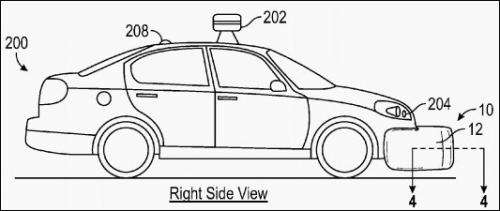March 27, 2015 weblog
Google patent focuses on pedestrian protection in vehicle impact

Accidents happen. Motorized vehicles may collide with other vehicles or people. Conventional bumpers may protect the car against damage in the event of a collision but are not so kind to pedestrians. Imagine a bumper system with protective material that could sit on the outside of the car, as a buffer for pedestrians. Any pedestrian who has been hit by a car, and sent flying to the pavement on impact, might agree: a kinder, softer bumper is a nice idea.
Google is thinking on those lines, given a patent this month for a "System for pedestrian leg protection in vehicle impact." The patent was filed back in 2013 and published on March 24. Inventors named are Jonathan Switkes and Daniel Lynn from San Jose and Alex Khyakin from San Francisco. The patent said, "Vehicle bumpers are generally designed to absorb energy to prevent injury to the vehicle itself during a collision. ... However, they are generally much too hard to provide cushioning to a pedestrian involved in a collision with a vehicle."
What Google proposed: "A system for protecting a pedestrian during impact with a vehicle, comprising: a bumper adapted for attachment to an end of the vehicle; wherein the bumper is comprised of a visco-elastic material; wherein the bumper has a horizontal thickness that extends from the end of the vehicle; wherein the visco-elastic material undergoes deformation and causes deceleration along the horizontal width of the bumper during impact between the pedestrian and the bumper; wherein the visco-elastic material does not immediately return to an original shape after impact thereby reducing spring back of the bumper on the pedestrian, and wherein the bumper is comprised of gaps within the visco-elastic material that reduce an overall bulk modulus of the bumper."
Engadget senior editor Mat Smith translates: a system of inflatable bumpers for driverless cars. The "visco-elastic material," said Smith, is "a wonder-material that would offer a degree of give when coming into contact with objects (or what we like to call 'people')."
As a Quartz headline to a story from reporter Mike Murphy read, "Google's driverless car might come with airbags on the outside, to protect pedestrians."
Google offered two ideas for exterior bumpers. In one embodiment, the bumper is formed of a structure composed of multiple air sacs, which could be small, medium, or large from 1 mm to 100 mm or larger. The air sacs may be made from a polymer or elastic material and filled with air or other suitable gas and/or liquid. The design would be such to reduce or eliminate spring-back that may cause the pedestrian to suffer impact with the roadway or other object. In another embodiment, the bumper is formed of a visco-elastic material that absorbs impact energy. "A low cross-linked silicone or acrylic is a good choice for this material," according to the patent.
"When using a vehicle bumper comprised of a visco-elastic material, in a pedestrian impact the viscous material is forced to move out of the way of the pedestrian's legs and lower body. Relative speed between the vehicle and the pedestrian would be gradually slowed as the viscous losses in the material convert kinetic energy to heat."
The idea is to prevent injury to the pedestrian during the initial impact with the vehicle bumper. "Because the material is highly viscous, spring back is minimal and very well damped. This helps prevent the pedestrian from rebounding off the vehicle and incurring a dangerous secondary impact with the road surface or other object."
The patent authors pointed out that the embodiments described are designed to provide protection to a pedestrian in a collision between a pedestrian and a vehicle traveling up to 25 miles per hour. They noted that the bumper-system embodiments may be used on any type of vehicle, including conventional automobiles as well as those in autonomous mode.
More information: System for pedestrian leg protection in vehicle impact, United States Patent.
© 2015 Tech Xplore


















